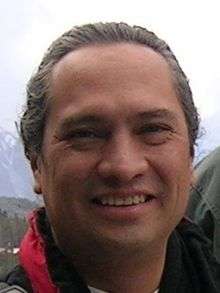Francisco Valero-Cuevas
| Francisco Valero-Cuevas | |
|---|---|
 | |
| Residence | United States of America, Mexico |
| Fields | Biomedical Engineering, Mechanical Engineering, Biokinesiology, Physical Therapy |
| Institutions | University of Southern California, Cornell University, Stanford University |
| Alma mater | Stanford University, Queen's University, Swarthmore College |
| Thesis | Identification of Biomechanical Factors Limiting Finger Force Production (1997) |
| Doctoral advisor | Felix Zajac |
| Known for | Motor control, Biomechanics |
Francisco J. Valero-Cuevas is an Engineer of Mexican origin, and a Professor of Biomedical Engineering, and Biokinesiology and Physical Therapy at the University of Southern California. He is known for his work on how the human hand works, and its clinical applications. He is notable for several inventions, including devices for measuring hand function,[1][2][3] leg function,[4] and the construction of archways in civil engineering.[5] Among his scholarly contributions is a textbook on the mathematical foundations underlying the study of motor control and biomechanics.[6] He is an Elected Fellow of the American Institute for Medical and Biological Engineering (AIMBE) (2014), an Elected Senior Member of the Institute of Electrical and Electronics Engineers (IEEE), and a Thomas J. Watson Fellow.
Education
He graduated from Swarthmore College in 1988 with a BS in Engineering. As a Thomas J. Watson Fellow, he spent one year in the Indian Subcontinent, studying Philosophy and learning Hindi. In 1991, he received an M.S. from Queen's University in Mechanical Engineering, under the guidance of Prof. Carolyn Small. He joined Stanford University in the Department of Mechanical Engineering and obtained a PhD in 1997, under the guidance of Prof. Felix Zajac.
Career
His first job was as a Research Associate and a Lecturer at Stanford University in Mechanical Engineering. He then joined Cornell University's Sibley School of Mechanical and Aerospace Engineering as an Assistant Professor, with a joint appointment at the Hospital for Special Surgery as an Assistant Scientist. After being promoted to an Associate Professor (with tenure) in 2005, he moved to the University of Southern California as an Associate Professor (with tenure), then promoted to a full Professor in 2011. His primary appointment at the University of Southern California are in the Department of Biomedical Engineering and in the Division of Biokinesiology and Physical Therapy. He has joint appointments in the Department of Aerospace and Mechanical Engineering and the Department of Computer Science.
Notable contributions
Strength-Dexterity Test
This method for the assessment of hand function was invented by Francisco Valero-Cuevas in 2000, and available as a device.[1] He has applied this successfully to study hand function in adults with disabilities,[7] children,[8] and even for assessing leg function.[4] He founded a company in 2015, Neuromuscular Dynamics, LLC,[9] based on these devices.
Awards and honors
- 2015 Orange County Engineering Council OCEC President’s Prestigious Award, for Scholarly and Outstanding Contributions to the Engineering Profession.[10]:92
- 2014 Elected Fellow, College of Fellows of the American Institute for Medical and Biological Engineering (AIMBE) for Outstanding Contributions to the Mathematical and Engineering Understanding of the Neural Control of Limbs to Produce Versatile Function.[11]
- 2013 Outstanding Technical Achievement Award from the 25th Conference Hispanic Engineer National Achievement Awards Corporation (HENAAC), Great Minds in STEM.[12]
- 2013 Elected Senior Member of the Institute of Electrical and Electronics Engineers (IEEE).
- 2002 American Society of Biomechanics' Post-doctoral Young Scientist Award.[13]
- 2001 Whitaker Foundation.[14]
- 1988 Thomas J. Watson Fellowship to study Sankhya Yoga Philosophy in India and Nepal.
References
- 1 2 B1 US 6537075 B1, Valero-Cuevas, Francisco, "Device for developing and measuring grasping force and grasping dexterity", published Jan 11, 2000
- ↑ A1 US 20060293615 A1, Valero-Cuevas, Francisco & Daniel Brown, "Device and method for quantifying and extracting sensorimotor circuitry", published Dec 28, 2006
- ↑ A1 US 20100228156 A1, Valero-Cuevas, Francisco & Hans Forssberg, "Dexterity device", published Sep 9, 2010
- 1 2 Lyle, Mark A.; Valero-Cuevas, Francisco J.; Gregor, Robert J.; Powers, Christopher M. (2013). "The lower extremity dexterity test as a measure of lower extremity dynamical capability" (PDF). Journal of Biomechanics. 46 (5): 998–1002. doi:10.1016/j.jbiomech.2012.11.058. PMID 23357699. Retrieved 26 July 2016.
- ↑ A US 6000193 A, Valero-Cuevas, Francisco; Raimund Sulzenbacher & Stefan Hetzenauer, "Easily adjustable, reusable arch-forming assembly for creating a framework for constructing arches and archways", published Dec 14, 1999
- ↑ Valero-Cuevas, Francisco J. (2015). Fundamentals of neuromechanics. Biosystems & Biorobotics (Book 8). Springer. p. 194.
- ↑ Valero-Cuevas, Francisco J.; Smaby, Niels; Venkadesan, Madhusudhan; Peterson, Margaret; Wright, Timothy (2003). "The strength-dexterity test as a measure of dynamic pinch performance." (PDF). Journal of biomechanics. 36 (2): 265–70. doi:10.1016/S0021-9290(02)00340-8. PMID 12547365. Retrieved 26 July 2016.
- ↑ Vollmer, B; Holmström, L; Forsman, L; Krumlinde-Sundholm, L; Valero-Cuevas, FJ; Forssberg, H; Ullén, F (2010). "Evidence of validity in a new method for measurement of dexterity in children and adolescents." (PDF). Developmental medicine and child neurology. 52 (10): 948–54. PMID 20497459.
- ↑ "Neuomuscular Dynamics, LLC". Corporation Search California. Archived from the original on 2016-07-27. Retrieved 26 July 2016.
- ↑ OCEC. "2015 OCEC Award Program Booklet". Orange County Engineering Council. Archived from the original (PDF) on 2016-07-25. Retrieved 25 July 2016.
- ↑ "American Institute for Medical and Biological Engineering (AIMBE)". Francisco Valero-Cuevas, Fellow of the AIMBE. Archived from the original on 2016-07-25. Retrieved 25 July 2016.
- ↑ "2013 HENAAC Award Winners". Great Minds in STEM. Archived from the original on 2016-07-25. Retrieved 25 July 2016.
- ↑ "American Society of Biomechanics Awards and Grants". Archived from the original on 2016-07-25. Retrieved 25 July 2016.
- ↑ Brand, David. "Cornell's Valero-Cuevas receives Whitaker Foundation award to study biomechanics of the human thumb". Cornell Chronicle. Archived from the original on 2016-07-25. Retrieved 25 July 2016.
External links
- Faculty profile in Biomedical Engineering at USC.
- Faculty profile in Biokinesiology and Physical Therapy at USC.
- Brain-Body Dynamics Lab.
- Textbook on Fundamentals of Neuromechanics.
- Video lectures on neuromuscular systems.